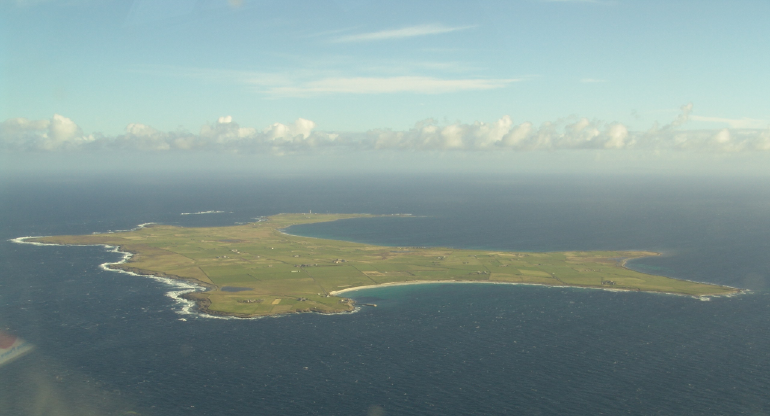

North Ronaldsay Lighthouse Cottages
Copyright © 2015- North Ronaldsay Lighthouse Cottages
The Story of the Lighthouses
The story of North Ronaldsay's lighthouses brings in much of Orkney's maritime history. The sea around the island has claimed many ships, and one of the biggest was the Swedish East Indiaman Svecia, which ran aground on the Reef Dyke in 1740. Her loss led to the charting of the waters around Orkney by Murdoch Mackenzie, the father of modern hydrography. He was a former student of the great mathematician Colin Maclaurin, who recommended him for the task.
Mackenzie's call for a lighthouse to be built on North Ronaldsay led in turn to the establishment of the Northern Lighthouse Board, who built the old lighthouse - the Old Beacon - in 1789, as one of their first four lights. It was built by Thomas Smith and his son-in-law, Robert Stevenson.
But it was too low, down by the shore, and its beam could all too easily be misinterpreted as a reassuring sign of a ship in safe waters. So its light was removed to Start Point in Sanday, and replaced by the stone ball that we see today.
The present-day lighthouse, built on higher ground, came into operation in 1854. It was built by Robert Stevenson's eldest son, Alan, whose previous accomplishments had included Skerryvore, the tall tower that stands on a reef 12 miles off the coast of Tiree. Alan Stevenson also built Ardnamurchan, and in Orkney the two Graemsay lights of Hoy High and Hoy Low.
The lighthouse that he built continues in operation today, a friendly sight on land as well as sea, as Peter A. Tulloch observed in his book A Window on North Ronaldsay:
'The flashing white light which sweeps over and lights up the land as well as the sea has always given direction to those who go out visiting on a dark night in that it has helped them to avoid the pitfalls of ditches and dykes. There can be no doubt that this beam has always been a grand morale-booster for us islanders as well as a welcome sight to the duty officer of many a passing ship.'
After it became automatic in 1998, the Lighthouse Board wanted the associated buildings to be transferred to the possession of the island, and so the North Ronaldsay Trust was formed. It acquired the three former lightkeepers' cottages, along with workshop buildings. One building now houses the island's woolmill, spinning the fleece from the native sheep, and one of the cottages now houses an interpretation centre with educational resources, together with a cafe and shop. The other two cottages have been refurbished for holiday accommodation.
Interpretation boards are also being developed for other sites in the area, including the Old Beacon, Bewan pier, and the disused foghorn. The foghorn itself has now been renovated for display.
The construction work at the New Lighthouse is now complete and the two renovated lightkeepers cottages are in high demand.
The shop is running, selling craft work from the island and many articles made from North Ronaldsay wool, as well as books, local silvercraft, and items coloured with dyewood from the Svecia.
The interpretation centre was completed in April 2008 and has had many visitors. It tells the story of life in North Ronaldsay, including the communal work of farming and looking after the island's native seaweed-eating sheep. A film made on the island is presented by Joni Craigie, interviewing other islanders about life today. Amongst the items for children is a foghorn sound, a Morse Code machine, and a computer navigational game, and there is an educational box for Orkney schools.
Display boards tell the story of the Svecia and other shipwrecks, the building of the old and new lighthouses, and the impact of Murdoch Mackenzie's surveys. There are old artefacts and photos from the past.
The original sundial will be put back in place after restoration. It was used by the keepers to set the time each morning, and to raise the flag at exactly 9 am. 'The latter signal,' commented Peter Tulloch, 'provided the islanders with an opportunity to synchronize their clocks and watches, an operation which incidentally removed any excuse for being late for the kirk!'
The Lighthouse
Tours of the lighthouse and Wool Mill are available, on Sunday sailing days throughout the summer and at other times by arrangement.
The lighthouse is the tallest land-based light in the British Isles, and the view from the top is superb. On a fine day you can see the other North Isles of Orkney, and north to Fair Isle in Shetland. On a not-so-fine day you can see out over surging seas with white-capped waves, and look around within the lighthouse at the gracefully-shaped components of the Fresnel lens that concentrates the beam.
There is much to see in the surrounding area. Down at the shore by the Old Beacon seabirds fly over the little loch beside it and native sheep pick their way over the rocks below.
Tours of the lighthouse cost £6.00 for adults and £4.00 for children, plus an extra £3.00 for both Lighthouse and Mill tours.
Contact the Light Keeper, Billy Muir, on Land Line 01857 633257 or Mobile 07703 112 224 to see when he is available for a guided tour or email for details to the address below.
Email to lighthousetours@northronaldsaylighthousecottages.co.uk
